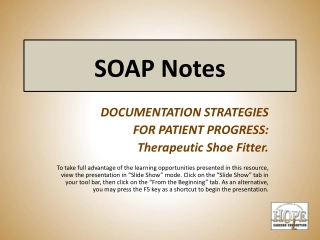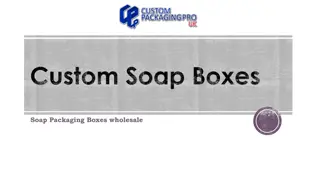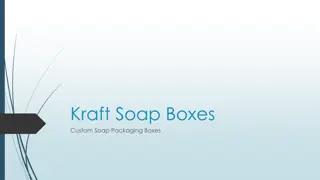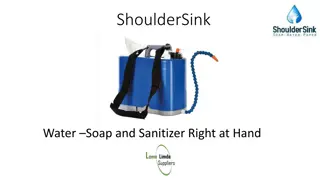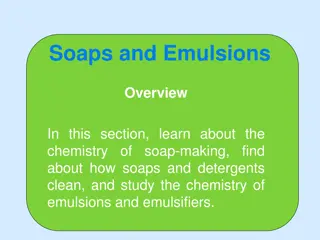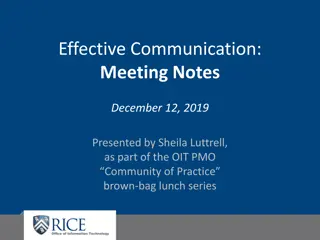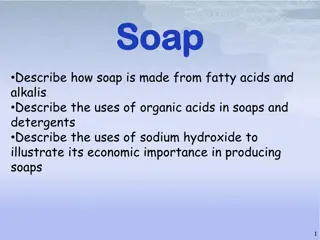Understanding SOAP Notes in Medical Documentation
A SOAP note is a vital tool for communicating health care information between providers about a patient. It consists of Subjective, Objective, Assessment, and Plan sections, providing a snapshot of a patient's healthcare encounter. This note serves as a common language for healthcare communication. The document also includes new terms, vital signs, contact information, and aims to enhance students' medical terminology knowledge and understanding of COVID-19.
Download Presentation

Please find below an Image/Link to download the presentation.
The content on the website is provided AS IS for your information and personal use only. It may not be sold, licensed, or shared on other websites without obtaining consent from the author. Download presentation by click this link. If you encounter any issues during the download, it is possible that the publisher has removed the file from their server.
E N D
Presentation Transcript
INTRO TO SOAP NOTES WESTSIDE HIGH SCHOOL DR. ANNA HARO FEBRUARY 2022
LEARNING OBJECTIVES TEKS: 130.223. (c)(1)(A) AND (B) & (2)(A) AND (B) Students will develop new knowledge of medical terminology related to SOAP notes. Students will compare and contrast the 4 sections of a SOAP note. Students will demonstrate their prior knowledge of COVID-19.
OBJETIVOS DE APRENDIZAJE TEKS: 130.223. (c)(1)(A) AND (B) & (2)(A) AND (B) Los estudiantes desarrollar n nuevos conocimientos de terminolog a m dica relacionada con las notas SOAP. Los estudiantes comparar n y contrastar n las 4 secciones de una nota SOAP. Los estudiantes demostrar n su conocimiento previo de COVID-19.
A. Definitions SOAP Subjective Objective Assessment, including the Problem List Plan 1. 2. 3. 4. 5. OUTLINE B. New Terms/Abbreviations C. Vital Signs BP HR T RR O2 1. 2. 3. 4. 5.
Definiciones: A. 1. SOAP 2. Subjetivo 3. Objetivo 4. Evaluaci n, incluyendo la lista de problemas ESQUEMA DEL TEMA 5. Plan B. Nuevos t rminos C. Signos vitales 1. BP 2. HR 3. T 4. RR 5. O2
CONTACT INFO Remind App: Text @DrHaroM to the number: 81010 (remember the @ symbol) INFORMACI N DEL CONTACTO HISD Email: Anna.Haro@Houstonisd.org Anna.Haro@Houstonisd.org Office Hours: aily during lunch, room South 114
A SOAP note is a medical documentation tool used to communicate health care information about a specific patient between health care providers. Dissect the sentence above for the description of a SOAP note: A. DEFINITIONS 1. WHAT IS A SOAP NOTE? 1. Medical Documentation Tool 2. It is used to communicate health care information 3. The SOAP note is about one patient 4. It is used to communicate between health care providers. It uses a common language. (What is the common language called?)
A SOAP note is a medical documentation tool used to communicate health care information about a specific patient between health care providers. The SOAP note usually represents a snap-shot of one health care encounter at a moment in time (one office visit, a specific health consultation, one ER visit, etc) A. DEFINITIONS 1. WHAT IS A SOAP NOTE? The SOAP note also provides a broad overview of the patient s past medical history, including their health conditions and current medications. The fours sections of a SOAP note include: Subjective Objective Assessment Plan
The S stands for subjective information. The subjective information contains the medical information and observations from the viewpoint of the patient. Ex. the patient complains of (In your literature courses, what or who is referred to as the main subject? Are there comparisons with the SOAP note?) A. DEFINITIONS 2. WHAT IS SUBJECTIVE? Subjective information includes health care information that CANNOT be verified by lab work, diagnostic tests, or other means of measurement.
The O stands for objective information. The objective information contains the medical information and past medical history that can be _________ or confirmed. A. DEFINITIONS 3. WHAT IS OBJECTIVE? Objective information includes health care information that CAN be verified by lab work, diagnostic tests, or other means of measurement. (What type of medical tests and measurements can patients receive?)
The Assessment includes a complete list of all the patient s medical problems and their current medications. A. DEFINITIONS 4. WHAT IS THE ASSESSMENT? WHAT IS THE PROBLEM LIST? The Problem List is listed in order of priority most severe or most urgent medical problems are listed first, with lesser problems down the list. The list includes both acute illness and chronic illness. (What is the difference between acute and chronic?) The assessment also includes a list and explanation of the patient s complete medication list, including drug allergies, OTC, RX, and vitamin/supplements. This complete list can be obtained from the patient during the CMR comprehensive medication review.
The plan explains the actions and changes the patient will take to improve their health condition. The plan should always include: A. DEFINITIONS 5. WHAT IS THE PLAN? 1. Goals of tx for the new dx 2. New RX and other tx for the new dx 3. Follow-up instructions for the new dx (how/when to contact, what to do if condition worsens ) 4. Changes/Continuations: should there be changes to existing medications? Changes to other tx? Note: every dx in the Problem List should be addressed in the plan.
The SOAP note uses medical abbreviations to communicate. Today, we will skim over a long list of abbreviations used in the subjective and objective sections of the SOAP note. B. NEW TERMS As we continue learning new DX and tx throughout the year, we will add more abbreviations and symbols used to document information on the SOAP note.
MEDICAL TERMS AND ABBREVIATIONS FOR SUBJECTIVE INFORMATION CC = chief complaint c/o = complains of pt = patient s/sx = signs and symptoms yo or y.o. = years old HPI = history of present illness x = for/duration of (ex. x 1 wk or x 2 d) = male (2642 alt x no spaces) = female (2640 alt x no spaces) d = day or days wk week or weeks NB = non-binary mo month or months WDWN = well-developed, well- nourished HA = headache P = pain
MEDICAL TERMS AND ABBREVIATIONS FOR SUBJECTIVE INFORMATION N = nausea EtOH = (ethyl) alcohol V = vomiting PPD = packs per day D = diarrhea FHx = family history C = constipation CVD = heart dx N/V = nausea and or vomiting HTN = high blood pressure N/V/D nausea, vomiting, diarrhea AMI = heart attack DM = diabetes hx or Hx = history CA = cancer SHx = social history
MEDICAL TERMS AND ABBREVIATIONS FOR OBJECTIVE INFORMATION Blood tests: BMP = basic metabolic panel CMP = comprehensive metabolic panel CBC = complete blood count Diff = differential WNL = within normal limits RBC = red blood cells WBC = white blood cells Fe = iron Alb = albumin LFT = liver function tests BUN = blood urea nitrogen Cr = serum creatinine est. CrCl = estimated creatinine clearance BG = blood glucose FBG or FPG = fasting blood/plasma glucose Lipid panel includes the following 4 tests: TC = total cholesterol HDL = good cholesterol LDL = bad cholesterol TG = triglycerides HCG = human chorionic gonadotropin CPK = creatinine phospho kinase CEA = carcinogenic embryonic antigen 1. 2. 3. 4.
MEDICAL TERMS AND ABBREVIATIONS FOR OBJECTIVE INFORMATION PMH = past medical history NKDA = no known drug allergies pcn = penicillin(s) Diagnostic tests: XR = X-ray CXR = chest x-ray (XRT = radiation or radio-therapy) bx = biopsy cx = culture MDR = multi-drug resistant MRI = Magnetic Resonance Imaging CT or CAT = Computerized tomography PET = Positron Emission Tomography UA = urinary analysis EKG or ECG = electrocardiogram BRBPR = bright red blood per rectum OGTT = oral glucose tolerance test
What is meant by the term vital signs? What would happen if a patient did not have one of the vital signs? C. VITAL SIGNS What are the most vital and essential functions of human life without which, we would not survive within minutes?
BP = Blood pressure Normal blood pressure is 120/80 mmHg C. VITAL SIGNS 1. BP High BP is considered greater than 140/90 mmHg Low is considered less than 90/60 mmHg Notice the correct way BP is written, spoken and the units.
HR = Heart Rate (or sometimes called pulse) Normal HR is between 60 100 bpm Tachycardia is HR > 100bpm C. VITAL SIGNS 2. HR Bradycardia is HR < 60 bpm There are some variations to the normal levels based on underlying CV health. (Can you think of reasons why a patient could have a lower heart rate but still have a healthy heart?) Notice the correct way HR is written, spoken and the units.
T = temperature C = Celsius or centigrade F = Fahrenheit C. VITAL SIGNS 3. T Normal T range = 97 - 99 F Average T = 98.6 F (37 C) Fever: T > 100.4 F (>38 C) Low is considered less 97 F (36.1 C) = hypothermia Notice the correct way T is written, spoken and the units
RR = Respiratory Rate Normal RR is between 12-20 bpm C. VITAL SIGNS 4. RR Tachypnea is RR > 22 bpm Medical professionals may us the term hyperventilation vs. hypoventilation. (What is the difference between these two? What is the end result?) Notice the correct way RR is written, spoken and the units.
O2 = oxygen saturation or sometimes called pulse Ox Normal O2 > 95% C. VITAL SIGNS 5. O2 Hypoxia results when the oxygen level is too _________. As oxygen levels decrease, carbon dioxide increases, and this can lead to serious consequences throughout the body. Notice the correct way O2 is written, spoken and the units.
C. VITAL SIGNS THE FINAL ABBREVIATION (OF THE SLIDES) VSSAF = Vital signs stable afebrile
QUESTIONS? Type questions in the chat or: Email me: Anna.Haro@Houstonisd.org Send me a message via Remind Join me at Office Hours during lunch




